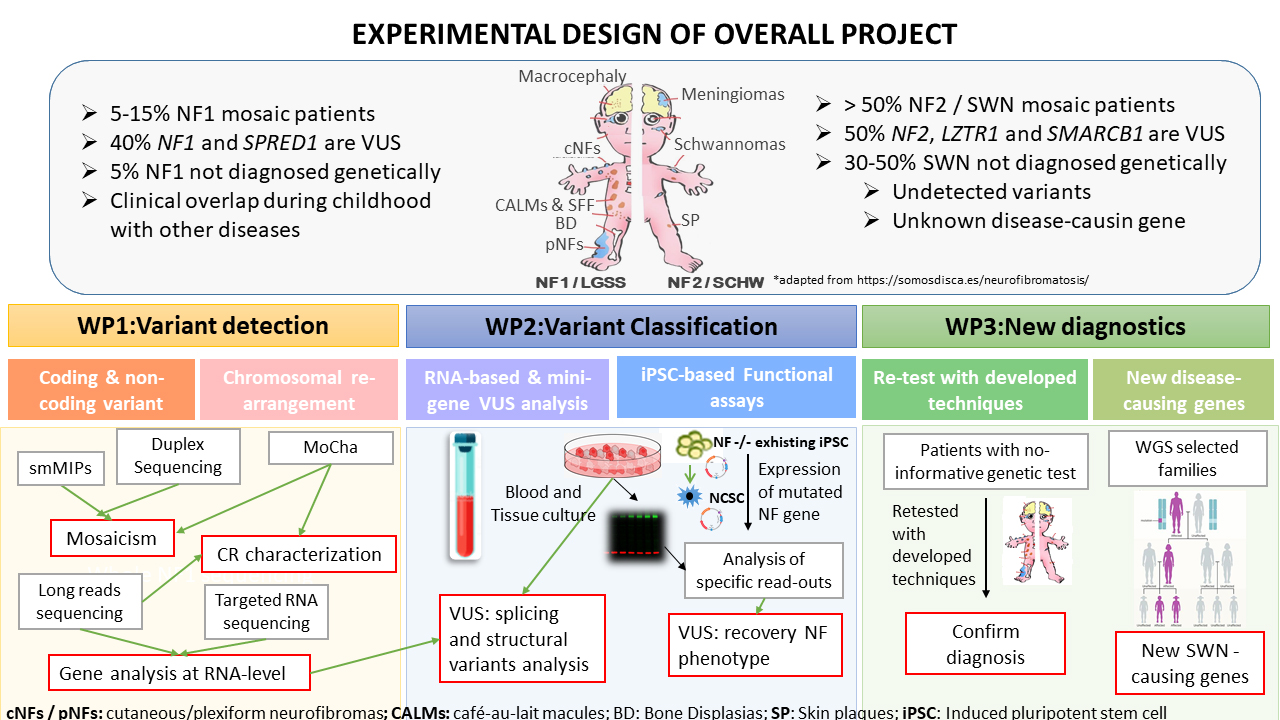IGTP will coordinate a European project to improve the diagnosis and treatment of neurofibromatoses

Researchers from the Clinical Genomics Group at Germans Trias i Pujol Research Institute (IGTP) and the Genetics Service at Germans Trias i Pujol Hospital (HUGTiP) will coordinate the project EURONET-NF, which aims to improve genetic diagnosis for patients with neurofibromatoses and schwannomatosis (NF-SWN). The project, which involves 6 countries, has been awarded around €1.6 million in funding by the European Union for the next 3 years.
The IGTP's Clinical Genomics Group and the HUGTiP's Genetics Service, which are members of Spanish CSUR and European ERN Genturis, reference centres in neurofibromatosis, schwannomatosis and related syndromes (phakomatosis), have been selected to coordinate the European project EURONET-NF for the study of neurofibromatoses. The "European Network for the improvement of the molecular diagnosis of neurofibromatoses, schwannomatosis and related disorders", an initiative from IGTP, includes several European reference centres and will be launched next March. This initiative has received European funding from the 2022 Joint Transnational Call of the EJP RD for the research project on rare diseases (JTC 2022).
"It is a privilege to be able to coordinate groups with a wealth of experience that are a benchmark in genetic diagnosis within Europe. Everything has been very easy, we all have the same goal to improve diagnosis and treatment for this group of rare diseases," explains Dr Elisabeth Castellanos, coordinator of the Clinical Genomics Group at Barcelona North Metropolitan Area Clinical Laboratory (LCMN), Germans Trias i Pujol Hospital, and associate researcher at IGTP. The research conducted within this project will have an impact, as it will help to meet important unmet clinical needs, such as improving genetic diagnosis and its efficiency, dealing with new cases, reducing the diagnostic gap within Europe, sharing protocols and tools developed during the project to any site that performs these tests, and improving the clinical management of these patients. The approach is very systematic and can be applied to other genetic diseases.
Particularly for rare diseases, such as NF, patients' and relatives' associations are a key component: "The project has been enabled by a close collaboration with patients' associations from all participating countries, which will help us to find patients with this disease and provide tools to share results to these patients," explains Dr Castellanos.
Neurofibromatoses as rare diseases
Neurofibromatoses include three rare disorders: NF1, NF2 and schwannomatosis non-related to pathogenic variants within the NF2 gene. Similarly, Legius syndrome and constitutional mismatch repair deficiency (CMMRD) (deficiency of DNA repair genes) are rare diseases and both are alternative diagnoses for suspected NF1. The majority of these five disorders are complex, potentially impact most organ systems and are associated to a high risk of cancer that requires appropriate monitoring and management. Therefore, an early genetic diagnosis is essential for the recovery of patients and to define more efficiently the global policies and strategies for patient care. Despite this, "every day we face complex challenges with genetic diagnosis. Current techniques can miss the pathogenic variant (the one that causes the disease) within the target gene. In addition, for many identified variants, it is not clear whether they cause the disease. In addition, some lab procedures are expensive and highly specialized," explains Dr Castellanos.
The aim of the group is to develop and share new high-throughput sensitive techniques at the DNA, RNA and protein levels, and bioinformatic tools for global use in the genetic diagnosis of NF-SWN and related disorders. "Although we are aware that not all patients can be diagnosed, we hope to improve genetic diagnosis for most patients who do not have a diagnosis". For a specific subset of patients with a negative test result, we will look for new candidate genes. In addition, clinical criteria for constitutional mismatch repair deficiency (CMMRD) syndrome testing will be assessed in children with suspected NF1/LGSS for whom diagnosis could not be confirmed by genetic testing. The improvement in genetic diagnosis for NF and related disorders using new assays with high sensitivity and specificity will open new avenues for patients, with improvements in treatment, follow-up and family planning.

Figure 1: Graphical scheme of the project. At the top, we summarize the main clinical issues for each group of diseases, particularly NF1 and Legius syndrome, and NF2 and schwannomatosis. At the bottom, we show the methods used to achieve the three main goals: to improve the techniques used to increase performance for detecting variants, to improve classification of these variants, and to determine whether these variants cause the disease, and finally, to retest patients with undetermined results in previous genetic testing so as to confirm a clinical suspicion and identify the germline variant causing the disease.
About the Clinical Genomics Research Group
Currently, the Clinical Genomics Research Group, co-directed by Dr Ignasi Blanco, Clinical Director of LCMN, and Dr Castellanos, is the Genetics Service of Barcelona North Metropolitan Area Clinical Laboratory (LCMN) at Germans Trias i Pujol University Hospital. The group performs the diagnosis and follow-up of patients with genetic diseases, and other clinical services at the hospital or other sites. The group also provides genetic counselling to these patients and their families, and manages all testing required for identification of the gene causing these diseases.
One of the goals of the group is to improve the management of these patients based on their clinical diagnosis and also the emotional, social, religious and physical components that may be relevant for the patient. In addition, in order to increase the throughput of genetic testing and our understanding of the genetic underpinnings of certain diseases, the research is being focused on the development of new genomic techniques, at the RNA and DNA level, to test for germline and somatic variants. Finally, as members of a reference centre in phakomatoses, we are actively involved in the development and implementation of new gene therapies for schwannomatosis and neurofibromatoses.
